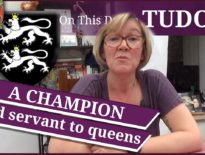On this day in Tudor history, 16th April 1550, alchemist, apothecary and physician Francis Anthony was born, probably in London. He had a rather eventful life, being imprisoned on several occasions, and he made his fortune from his invention aurum potabile, drinkable gold, which he claimed had amazing curative powers.
Find out more about Francis Anthony and why he ended up in prison in today's talk.
Also on this day in Tudor history, 16th April 1570, Gunpowder Plot conspirator Guy Fawkes was baptised in York. Find out more about him in last year’s video:
Also on this day in history:
- 1512 – The Mary Rose began her first tour of duty in the English Channel on the hunt for French warships.
- 1521 – German Protestant reformer, Martin Luther, appeared in front of Emperor Charles V at the Diet of Worms. He had been summoned to the diet to either recant or reaffirm his religious views.
- 1578 – Burial of Thomas Drant, Church of England clergyman and poet. He was part of the “Areopagus” intellectual circle at court, but also had an ecclesiastical career and was chaplain to Edmund Grindal, Bishop of London. He is known for his work on prosody (metre), and actually drew up some rules concerning it, which were mentioned by Edmund Spenser, Gabriel Harvey, Philip Sidney, Edward Dyer and Fulke Greville.
- 1587 – Death of Anne Seymour (née Stanhope), Duchess of Somerset and wife of Edward Seymour, Duke of Somerset and Lord Protector during part of Edward VI's reign. Anne was a reformer and a literary patron. She died at Hanworth Place and was buried at Westminster Abbey.
- 1595 – Death of Ferdinando Stanley, 5th Earl of Derby and literary patron. His sudden death caused rumours of poisoning and witchcraft, but nothing was ever proved. Stanley was patron of the Strange's Men company of players, which probably included William Shakespeare, and he was also a patron of poets. It is thought that he also was a poet.
Transcript:
On this day in Tudor history, 16th April 1550, alchemist, apothecary and physician Francis Anthony was born, probably in London. He had a rather eventful life, being imprisoned a few times, and was also known for his remedy, aurum potabile (drinkable gold), which was made from gold and mercury, and which he sold, claiming that it had amazing curative powers. Hmmmm….
Let me tell you a bit more about this interesting man…
• Francis was the eldest son of goldsmith Derrick Anthony and his first wife, Elizabeth Erley. Derrick was chief graver of the royal mint between 1552 and 1599.
• Francis was educated at Cambridge and obtained a BA and MA.
• He was married three times – His first wife was Jane Howe, and he had two children by her before she died in around 1580. He then married Alice Hawes and had eight children by her. Then, in 1609, following the death of Alice, he married widow Elizabeth Lante.
• On his father’s death in 1599, Francis’s brother, Charles, succeeded him as chief graver at the mint, while Francis concentrated on his study of chemistry.
• The need for an income made Francis begin practising as a physician, but he didn’t have a licence and so, after he didn’t heed the warnings of the College of Physicians, he was fined and imprisoned three times. His wife’s pleading of the family’s poverty and the intercession of a friend saw him being released after the third and final time.
• He still didn’t take heed and the College met about him and wanted to prosecute him on another 17 occasions. They did summon him once, but he didn’t turn up.
• In 1608 he became an MD as a member of Pembroke College, where his son, John, was a student. By that point he’d been using his aurum potabile, his drinkable gold which he made from gold and mercury, and the college appointed Sir Thomas Knyvett, a warden of the king’s mint, as an expert judge to hold a trial of this medicine at a special court at the college in April 1609. Francis’s biographer, F V White, writes of how both sides, the College and Francis, claimed victory at the trial.
• In 1610, Francis published his “Medicinae chymicae et veri potabilis auri assertio”, his medical and chemical assertion of drinkable gold, which he dedicated to King James I. The College of Physicians refuted it but Francis carried on selling his potion, and in 1616 he published an answer to the college’s refutation. In 1618, he published his original asserio and his answer complete with an endorsement from the king himself. F V White explains that the king’s endorsement combined with publicity led to Francis making a fortune from his drinkable gold. He was able to buy shares in the colony of Virginia.
• He died on 26th May 1623 and was laid to rest at St Bartholomew-the-Great in London.
• F V White explains that although many may have viewed him as a charlatan, that “In person, however, he was assured, courteous, and truthful”, and his friends and family loved him and he left money to the poor. The poem on the memorial erected by his son, John, reads:
“There needs no verse to beautifie thy praise
Or keepe in memory thy spotles name
Religion, vertue, and thy skil, did raise
A threefold pillar to thy lasting fame.
Though poisnous envye ever sought to blame,
Or hyde the fruits of thy intention,
Yet shall they all commend that high desygne
Of purest gold to make a medicine
That feele thy helpe by that thy rare invention.”



Thank you for this fantastic article about my ancestor. My only regret is I have not even come close to his stature in any way. We have so many historical family members yet I’m sort of the “lost sheep.” lol Jesse B, Susan B. Henry Bowen, all Anthonys in my lineage. I’m pleased to have found this article. Thank you. The only thing I have to contribute to our society is my sort of eclectic type of music & art. https://pleiadiandragon.com
Thank you…… Herb A